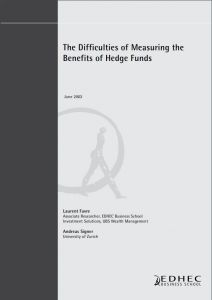

The Difficulties of Measuring the Benefits of Hedge Funds
In this paper, the use mean-variance approach for the determination of the benefits of allocations to hedge funds is critically evaluated. The advantages of investing in hedge funds are often explained and demonstrated with reference to a shift in the efficiency frontier of traditional portfolios. The added value of hedge funds is almost always indicated in a mean-standard deviation environment and should in our view be reconsidered. The estimated risk exposure can be quantified by the introduction of Value-at-risk analysis corrected according to higher moments of distribution. With this new risk measure, we are able to obtain a corrected value. A revisited version of this paper was published in the Summer 2002 issue of the Journal of Alternative Investments.
Author(s):
Summary:
In this paper, the use mean-variance approach for the determination of the benefits of allocations to hedge funds is critically evaluated. The advantages of investing in hedge funds are often explained and demonstrated with reference to a shift in the efficiency frontier of traditional portfolios. The added value of hedge funds is almost always indicated in a mean-standard deviation environment and should in our view be reconsidered. The estimated risk exposure can be quantified by the introduction of Value-at-risk analysis corrected according to higher moments of distribution. With this new risk measure, we are able to obtain a corrected value. A revisited version of this paper was published in the Summer 2002 issue of the Journal of Alternative Investments.
Register to download PDF
Register/Log in| Type : | Working paper |
|---|---|
| Date : | 13/06/2002 |
| Keywords : |
Asset Allocation |

